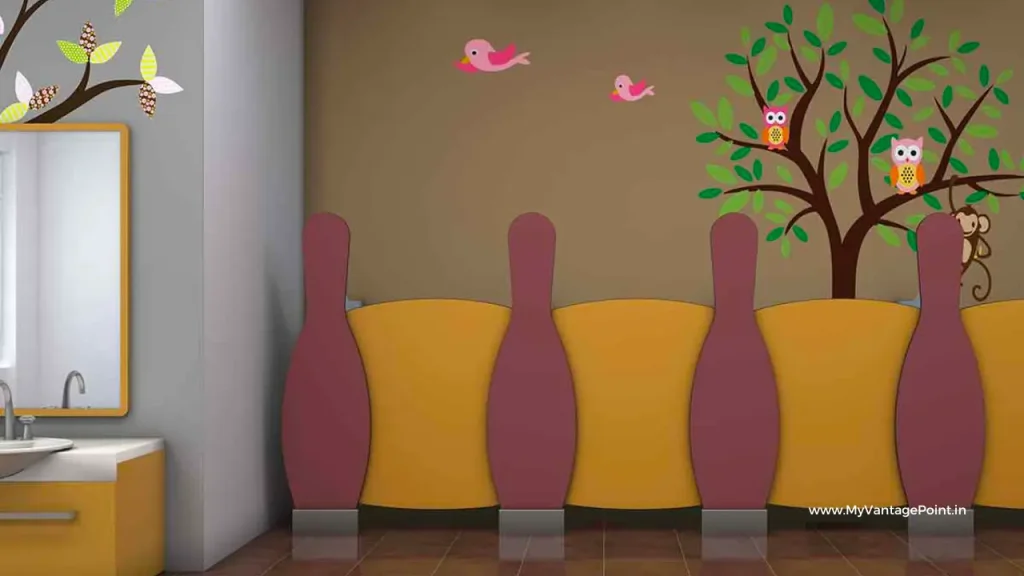In today’s dynamic and rapidly evolving world, sustainability has emerged as a defining force across diverse industries, influencing even seemingly overlooked areas such as restroom design. Sustainable restroom solutions necessitate critical consideration of various factors, with the selection of cubicles playing a pivotal role.

This discussion illuminates the indispensable contribution of cubicles in cultivating eco-conscious and all-encompassing restroom environments. Mr. Madhusudan Lohia, Director of Merino Industries Ltd., emphasizes the significance of restroom cubicles in fostering spaces that prioritize both environmental responsibility and inclusivity. Here are five key ways in which these cubicles contribute to the sustainability of restroom designs:
1. Durable and Low Maintenance:
Sustainability is synonymous with reducing the need for frequent replacements. High-quality restroom cubicles are designed to be highly durable, minimizing resource consumption. Their soft, non-porous surfaces discourage the accumulation of dust and bacteria, creating a cleaner and healthier restroom environment. Premium restrooms are built upon a self-sustained structure with very few supporting accessories, facilitating unmatched abstraction for detailed construction finesse.
2. User Comfort and Safety – Women and Geriatric:
Prioritizing user comfort is a critical aspect, particularly for women. Restroom cubicles are crafted to be anti-static and warm to the touch, elevating the overall user experience. Scratch and water-resistant qualities ensure that the cubicles maintain their appearance and functionality over time, adding to their sustainability aspect. Mr. Lohia mentioned, “Stainless steel-backed top rails, available in rectangular and round options, provide an elegant look and rich functionality, contributing to enhanced comfort.” He further added, “Integrating advanced security measures, such as surveillance systems or proximity sensors, fosters a safer environment for women using public restrooms, offering reassurance and peace of mind during their travels.” In addition to prioritizing user comfort, it’s imperative to underscore the significance of maintaining impeccable sanitation standards. Restroom cubicles are meticulously designed to align with these priorities, incorporating materials with antimicrobial properties to ensure a germ-free environment. “The industry’s commitment extends to easy cleaning and disinfection protocols, maintaining impeccable sanitation standards that underscore the collective dedication to both comfort and health in public restroom facilities”, explains Mr. Lohia.
3. Eco-Friendly Material Composition:
Incorporating eco-friendly materials in restroom cubicles is crucial. By being recyclable, these cubicles significantly diminish the environmental footprint associated with restroom design and construction. Furthermore, their composition avoids the emission of toxic or caustic gases, promoting the well-being of both the environment and its users.
4. Vibrant Design and Customization:
In contemporary design, restroom cubicles seamlessly blend vibrant aesthetics with advanced technology, ensuring resistance to abrasion and graffiti for lasting appeal. Designed for high-traffic areas, they maintain brilliance over time, resisting fading, tarnishing, and rust. Mr. Lohia emphasizes, “These vibrant cubicles are ideal for high-traffic areas where playful kids may indulge in artistic expressions.” Applying varied colors and finishes, in line with the latest trends, enhances their visual appeal. “The integration of vibrant design, cutting-edge technology, and sustainable materials creates a harmonious blend, providing lasting aesthetics and functionality,” he further adds. Moreover, prioritizing water usage efficiency underscores the industry’s commitment to responsible resource management.
5. Accessibility for All:
Creating sustainable restrooms involves promoting inclusivity. Mr. Lohia explains, “Restroom cubicles need to be accessible for Divyangjan, with features such as ramps in public washrooms to assist individuals with diverse mobility needs. Ensuring that everyone, regardless of their physical abilities, can use these facilities comfortably contributes to a more inclusive and sustainable restroom environment.” From lightweight cubicles to those hanging from the ceiling, the installation of a cubicle system should prioritize functionality and minimal area wastage.
In conclusion, the pursuit of a perfect sustainable restroom design encompasses more than aesthetics; it is a holistic approach focusing on environmental responsibility and inclusivity. Restroom cubicles, often underestimated, play a significant role in achieving these goals by offering colorful, durable, eco-friendly, and user-friendly solutions while ensuring access for all. In a world where sustainability is a top concern, these cubicles are instrumental in creating restroom environments that benefit both users and the planet.
Read More
- The Leela Palace Bengaluru unveils The Maharaja Ballroom
- Percept ICE conceptualizes and produces the spectacular National Dealers Meet 2024 for Force Motors
- Katrina Kaif becomes the new face of Bonn Group & Americana Biscuits
- Recognizing Excellence in Indian Digital Content NEXA Sponsors SIIMA New Streaming Academy Awards 2024
- IPL Playoffs Decoded: How Rock Paper Rum Pairs Up with Each Team’s Spirit!